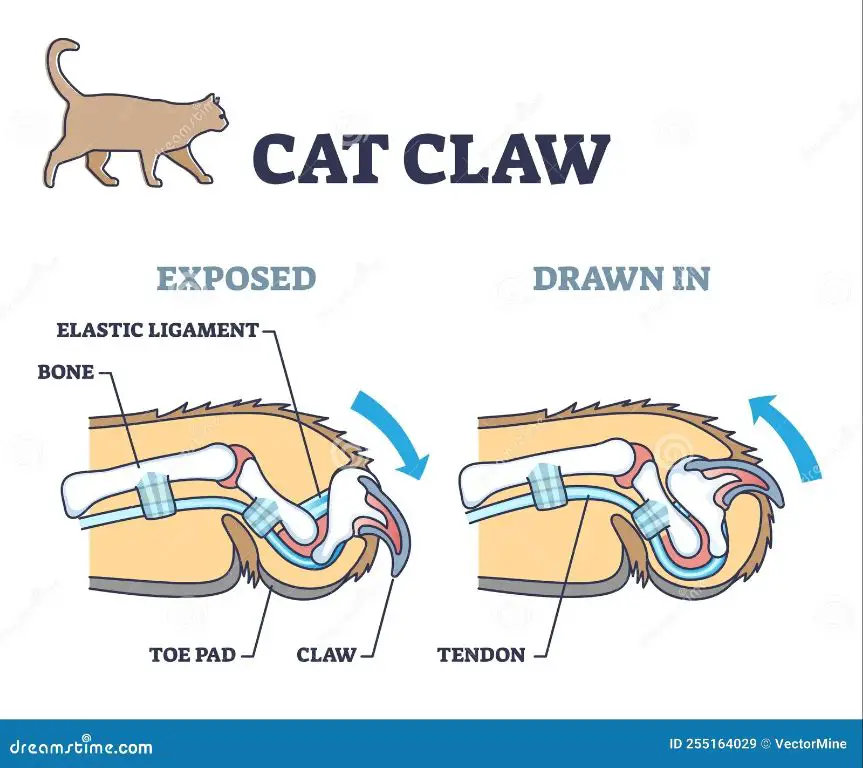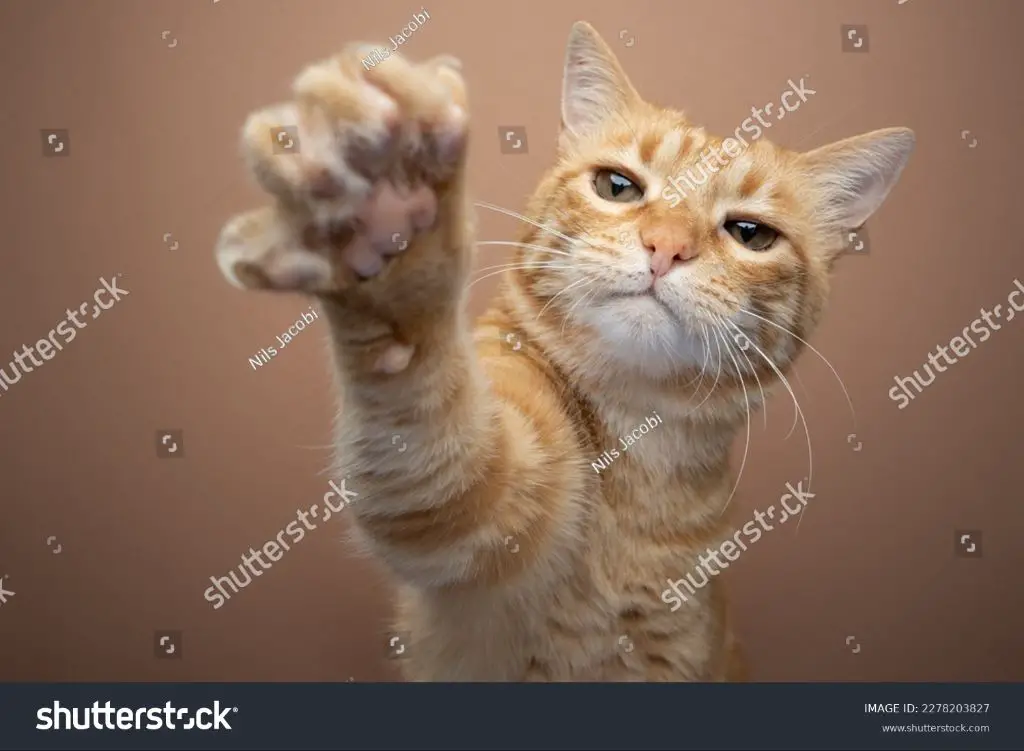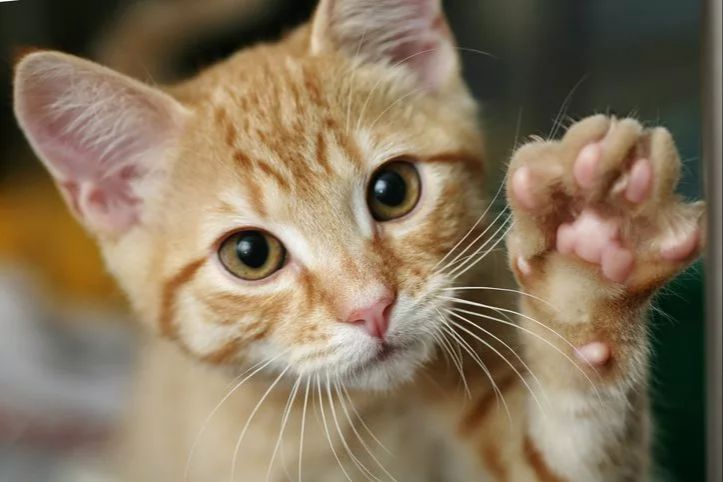Cats have a special anatomical feature – retractable claws. Retractable claws are claws that can be extended or retracted by a cat at will. When retracted, the claws are sheathed within the skin and fur around the toe pads. When extended, the sharp claws are exposed and ready for hunting, climbing, scratching and defending.
A cat’s claws are affixed to the last bone in each of its toes. This bone is attached to a tendon that connects to muscles in the cat’s leg. When the cat flexes its paws, the tendon pulls on the bone and extends the claws outward. When the cat relaxes its paw muscles, the claws retract back into sheaths of skin on the underside of its toes. This allows the cat to control its claws and keep them sharp.
Retractable claws give cats the ability to use their claws only when needed while keeping them protected when not in use. This helps facilitate climbing, scratching, hunting and other cat behaviors. It also allows housecats to keep their claws sharp without excessive damage to household items.
Anatomy of Cat Claws
A cat’s claws consist of the hard, curved claw itself and the surrounding tissues, muscles, and tendons that enable them to extend and retract. The outer layer of the claw is made of keratin and is called the claw sheath. Underneath the sheath, the actual claw itself is attached to the last bone in the cat’s toe. This bone is called the distal phalanx.

The claw and sheath grow continuously from the germinal matrix, which is the part of the claw under the skin that produces new keratin cells. As new layers are produced, older layers get pushed up and out, becoming the visible part of the claw. Connecting the claw to the bone are ligaments called extensor tendons. These allow the cat to extend or protract their claws.
For retraction, a cat has a flexor tendon that is attached to muscles further up the leg. When these protractor and flexor tendons are activated by muscles, they enable the cat to control extending and retracting their claws.[1]
Protraction and Retraction
Cats have a special anatomical structure that allows them to protract and retract their claws at will. Protraction refers to extending the claws out, while retraction pulls the claws back in. This is accomplished using the flexor and extensor muscles, tendons, and ligaments in the cat’s paws.
When a cat’s claws are retracted, the flexor tendons pull the bones in each toe backwards, curling the claws into sheaths of skin on the underside of the paw so they are not exposed. To protract or extend the claws, the cat activates the extensor muscles connected by long extensor tendons to each toe bone. This straightens out the curled toes and exposes the sharp claws.
Cats use a “passive retraction” system, meaning their paw structure allows the claws to be retracted without active muscle control. The elastic ligaments in a cat’s paw act like rubber bands to pull the claws back into a retracted position. This allows cats to conserve energy, keeping their claws retracted by default and only extending them when needed for hunting, climbing, scratching, or self-defense.
Having protractable claws provides cats with important abilities like climbing, capturing prey, territorial marking by scratching, and self-defense. The ability to retract the claws also keeps them protected and sharp for when they are needed.
Benefits of Retractable Claws
Retractable claws provide several key benefits for cats1. First, they allow cats to climb trees, fences, furniture and more with ease. The claws can dig into surfaces for grip and traction when needed. Yet when not in use, the claws retract back into the paws so they don’t get worn down from constant contact with the ground2.
Retractable claws are also extremely useful for hunting. Cats can quietly sneak up on prey without making noise with their claws extended. Then when they pounce, they can swiftly extend their sharp claws to help catch and grip prey. After catching it, the claws retract again so they don’t damage the prey.
In addition, retractable claws enable cats to scratch objects for many purposes – to trim their nails, mark territory, and stretch their bodies. Since the claws are not constantly extended, they stay sharper for effective scratching. The ability to retract protects the claws from excessive wear.
Finally, retractable claws serve as a defense mechanism for cats. If threatened, they can quickly extend their sharp claws to scratch and protect themselves. By keeping the claws concealed otherwise, cats avoid dulling them through excessive contact with the ground.
Comparison to Other Animals
Unlike most mammals such as dogs and bears, cats have retractable claws that they can extend and retract at will. Dogs have permanently protruding claws that do not retract [1]. Bears also lack the ability to retract their claws, which are always extended [2]. Retractable claws are a unique feature found primarily in cats and a few other animals like viverrids.
When a cat’s claws are retracted, they are up off the ground and not touching anything. This allows the claws to remain sharp for hunting, climbing, and self-defense. Permanently extended claws like those of dogs and bears become blunt and worn over time from constant contact with the ground. Cats’ retractable claws give them the advantage of having sharp claws when needed.
Additionally, the retraction mechanism allows the cat to walk more quietly and tread lightly. This aids their ability to stealthily hunt prey. Other animals like bears and dogs make noise when walking due to their permanently protruding claws.
By extending and retracting their claws at will, cats can conserve energy. They only deploy their claws when needed for specific activities, keeping them safely retracted the rest of the time.
Kittens Learning to Retract
Kittens are born with sharp claws, but don’t have the ability to retract them into their paws at first. According to experts, kittens start to gain control over protracting and retracting their claws around 3-4 weeks of age (Kitten Lady, n.d.). However, it takes time and practice for them to master this skill.

Initially, kittens’ claws are always extended. They use them to scratch, climb, and play. Around 4 weeks old, the kittens develop the anatomical structures in their paws to retract the claws. However, they have to learn how to control these muscles consciously. Kittens often get “stuck” with their claws out as they start figuring out how to flex them in and out (Reddit, n.d.).
It can take several weeks or even months for kittens to reliably control their claws and keep them retracted when not in use. Kittens should be discouraged from inappropriate scratching, but never punished, as they are still learning. Providing scratching posts and trimming claws can help minimize damage while they practice this new skill (The Cat Site, 2010). With time and positive reinforcement, kittens will learn to keep their sharp claws safely tucked away most of the time.
Declawing Cats
Declawing cats is a controversial procedure that involves the amputation of a cat’s claws. Though some cat owners opt for this to prevent furniture or carpet damage, declawing comes with significant risks and is opposed by many veterinarians and animal welfare groups.
Declawing involves surgically removing a cat’s claws by amputating the end bones of the cat’s toes. This is an elective procedure done for owner convenience and provides no medical benefit to the cat. The Humane Society states that declawing can cause long-term complications like pain, infection, and back problems.
Many countries have banned declawing as an inhumane practice, including the UK, Australia, and most of Europe. Some vets refuse to perform the procedure due to ethical concerns. While some owners feel declawing protects their furniture, alternatives like trimming claws or using scratching posts are safer for the cat’s health.
Claw Health and Care
Keeping your cat’s claws healthy and properly trimmed is an important part of care. Overgrown claws can snag and tear, causing pain and injury. Clipped claws are also less likely to damage furniture, carpets, and skin during playtime. Here are some tips for maintaining your cat’s claws:
Trim your cat’s claws every 2-3 weeks. Use sharp, high-quality trimmers designed specifically for cat claws. Avoid using human nail clippers as they can crush the claw. Only trim the sharp, curved tip, taking care not to cut into the pink quick which contains nerves and blood vessels. Cutting into the quick will cause bleeding and pain.

Look for the quick by shining a flashlight through your cat’s translucent claws. The pink center should recede as you trim off layers of the claw. Stop trimming if you see any sign of the quick. It is better to trim a little at a time than risk hitting this sensitive area.
Introduce claw care slowly and reward your cat with treats during and after each session. This will help create positive associations.
Apply a small amount of styptic powder to stop any bleeding if you accidentally nick the quick. Rinse claws after trimming to wash away debris.
Inspect claws regularly to monitor overgrowth and signs of issues like cysts, embedded debris, cracks, and infection. Seek veterinary care if you have any concerns.
Provide scratching posts, pads, and cat trees to help wear down claws naturally between trimmings.
Consider using soft plastic caps or covers if your cat’s scratching is excessive despite providing appropriate outlets. These act as gentle buffers rather than damaging claws.
Never attempt to remove the actual claw or perform at-home declawing, as this is extremely painful and will impact your cat’s health and quality of life.
With routine care and trimming, your cat’s claws can stay healthy and help avoid problems.
Problems with Retraction
There are several medical issues that can cause problems with a cat’s ability to retract their claws. These include:
Arthritis – Joint inflammation caused by arthritis can make it difficult and painful for a cat to flex their paws and retract their claws. Older cats are especially prone to developing arthritis. Treatment usually involves pain medication and joint supplements.
Nerve Damage – The nerves that control the muscles for protracting and retracting claws can become damaged due to injury or illness. This nerve damage prevents the cat from being able to control claw movement. There is usually no treatment beyond pain management.
Injuries – Trauma to a cat’s paws such as getting stuck in something or injuries between the toes can damage the tendons/ligaments involved in claw retraction. These injuries usually require rest, anti-inflammatories, and time to heal.
Overgrown Claws – If a cat’s claws become severely overgrown, the extra length and curvature may physically prevent the claw from retracting normally. Trimming the claws may help restore function.
Obesity – Carrying excess weight puts more strain on joints and tendons, making claw retraction difficult. Weight loss can improve mobility.
If a cat is having seemingly random problems retracting their claws, a veterinary exam is recommended to check for underlying illness or injury. With treatment, some cats may regain normal claw function.
Frequently Asked Questions
Here are some common questions about cat claw retraction:
Why do cats retract their claws?
Cats retract their claws for several reasons. Retracting the claws allows cats to silently sneak up on prey https://wonderopolis.org/wonder/How-Do-Animal-Claws-Retract. It also allows them to walk quietly and not get their claws caught on surfaces. Retracted claws are protected from wear and tear.
Do cats control when their claws come out?
Yes, cats have voluntary control over claw retraction. They can choose to protract or extend their claws at will. However, claws also come out involuntarily when a cat is startled or feels threatened https://www.vetstreet.com/our-pet-experts/whats-the-deal-with-retractable-claws.
Why do cats extend their claws when you pet them?
Cats extend their claws when pet as a reflex reaction to stimulation. It does not necessarily mean they are feeling threatened or want you to stop petting them. But it’s a good idea to pay attention to their body language and stop if they seem distressed.
How does the claw retraction mechanism work?

Cats have an anatomical structure called the https://wonderopolis.org/wonder/How-Do-Animal-Claws-Retract that allows them to flex their claws in and out. Muscles, tendons and ligaments control the protraction and retraction.
